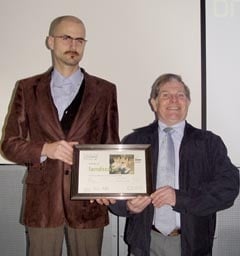Stone Federation Great Britain presented the first ever Natural Stone Sustainability Awards during the Natural Stone Show at ExCeL London this month. The Federation introduced the Awards to illustrate the sustainable qualities of natural stone and to recognise and reward outstanding achievement, awareness and innovation in sustainability in the natural stone industry. The Award-winning projects will act as a benchmark for achieving best practice in the sector, from extraction to the plethora of uses of stone in building. These are the winning projects.
Innovation
NAME OF PROJECT: Switched On
PROJECT OWNER: Forest Pennant
MAIN CONTRACTOR: Ossberger
OTHER CONSULTANTS INVOLVED: Kettle Civils, Dr A Hughes Atkins, Forestry Comission, English Nature
STONE USED IN CONJUNCTION WITH THE PROJECT: Royal Forest Pennant Sandstone
THE PROJECT:
Forest Pennant are the first specialist masonry company in the UK to generate their own green electricity using hydrogeneration. Close to an SSSI and just metres from the company’s extensive stoneworks, Forest Pennant, in the Forest of Dean, Gloucestershire, are harnessing the power of the River Lyd and 18th century workings that once provided the water power to an iron works. Forest Pennant have installed a micro hydrogeneration turbine to provide green power for the processing of their Royal Forest Pennant sandstone to produce a truly zero carbon building and hard landscaping material without offsetting.
JUDGES COMMENTS:
The installation and January 2011 switch-on of this 50,000kW hours/annum micro-hydro generating turbine is a true sustainability project. Primarily powering the processing of the local Royal Forest Pennant sandstone and its Forest of Dean sister plant distribution networks, any excess output of electricity is exported into the National Grid with further cost benefits for the company. Utilising the existing and adjacent mid-18th century Cannop ponds and their lade alignments, the project reinvigorates the intention of producing local power for local needs.
And, through capitalising on the existing industrial archaeology of the pond’s location, adequate head of water, and guaranteed rate of flow, the reintroduction and adoption of hydropower in this way creates an exemplary project. Fully accommodating the diverse ecosystem of the watercourse, the turbine house is constructed from the company’s sandstone in a manner that emulates historic precedents in scale, form and function.
Sustainability Awareness
NAME OF PROJECT: Biodiversity at Marshalls’ Stancliffe Stone
LOCATION: Landscape House, Grangemill, Matlock, Derbyshire
THE PROJECT:
Situated in the Peak District National Park, in 2009 Stancliffe Stone Quarry at Stoke Hall in Derbyshire gained accreditation to the Wildlife Trust’s Biodiversity Benchmark – the first business in Derbyshire and the first dimensional natural stone business in the UK to achieve and implement this system into its existing integrated management system.
Stoke Hall took two years to get accreditation, which shows a real commitment to wildlife and biodiversity and hard work and dedication to turn a biodiversity plan into an accredited site.
JUDGES COMMENTS:
The work at Stancliffe appears to be truly wonderful. The commitment required to make a project like this happen shows this is not in any way ‘greenwash’. This again shows true leadership within the industry and sets a standard that hopefully others will raise their game to.
From the evidence presented during the visit, the details submitted with the Award Application greatly underplays the significant scale of biodiversity work commitment and activities being carried out. In pursuance of a realistic, strategic, practical, and officially accredited biodiversity plan (covering the entire quarry site) the successful approach is to be greatly encouraged and positively endorsed.
Landscape
NAME OF PROJECT: Resurfacing of the Base Court at Hampton Court Palace
CLIENT/OWNER: Historic Royal Palaces
ARCHITECT/DESIGNER: Purcell Miller Tritton LLP
MAIN CONTRACTOR: Mansell Construction Services Ltd
PRINCIPAL STONE CONTRACTOR: A T Knott & Sons Ltd
STONE USED: Purbeck Limestone, Kentish Rag
THE PROJECT:
This is the recreation of a hard landscaping scheme originally designed by Christopher Wren and dating back to 1699-1700. All new paving was laid in a loose bedding of recycled concrete and crushed limestone. This alternative bedding and jointing technique was derived from historic (but in Britain almost forgotten) loose laid paving traditions. By avoiding cast concrete sub-grade base slabs and bedding mortars it was possible to reduce C02 emissions significantly, not only during construction but also in the future when maintenance works need to take place because all material can be re-used in situ.
The use of recycled and crushed bedding and jointing material creates a water permeable surface that reduces the pressure on the main sewers. It was also possible to source much of the irregular broken stones from existing stock that would otherwise have been regarded as waste. Therefore no additional energy-consuming work went into quarrying for the paving.
JUDGES COMMENTS:
The innovative use of a traditional technique integrates the old with the new so well. The workmanship is stunning, particularly in the way trip hazards have been eliminated while the percolated drainage takes the strain off the sewers, making this is a particularly sustainable project.

